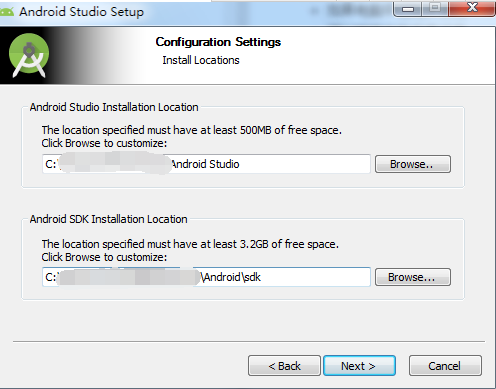編輯:關於android開發
“二維條碼/二維碼(2-dimensional bar code)是用某種特定的幾何圖形按一定規律在平面(二維方向上)分布的黑白相間的圖形記錄數據符號信息的;在代碼編制上巧妙地利用構成計算機內部邏輯基礎的“0”、“1”比特流的概念,使用若干個與二進制相對應的幾何形體來表示文字數值信息,通過圖象輸入設備或光電掃描設備自動識讀以實現信息自動處理:它具有條碼技術的一些共性:每種碼制有其特定的字符集;每個字符占有一定的寬度;具有一定的校驗功能等。同時還具有對不同行的信息自動識別功能、及處理圖形旋轉變化點。 [1] ”
上面是百度百科的解釋。既然有二維碼,那麼肯定有一維碼。
一維碼。最為常見的就是食品 & 書本後面的條碼。
條碼起源與20世紀40年代,後來在1970年 UPC碼發明,並開始廣泛應用與食品包裝。
具體的介紹可以看百度百科 一維碼。
其實二維碼與一維碼本質上是類似的,就跟一維數組和二維數組一樣。
為了讓java或者說android方便繼承條碼的功能,google就開發了一個zxing的庫:
https://github.com/zxing/zxing
public class EncodeThread {
public static void encode(final String url, final int width, final int height, final EncodeResult result) {
if (result == null) {
return;
}
if (TextUtils.isEmpty(url)) {
result.onEncodeResult(null);
return;
}
new Thread() {
@Override
public void run() {
try {
MultiFormatWriter writer = new MultiFormatWriter();
Hashtable<EncodeHintType, String> hints = new Hashtable<>();
hints.put(EncodeHintType.CHARACTER_SET, "utf-8");
BitMatrix bitMatrix = writer.encode(url, BarcodeFormat.QR_CODE, width, height, hints);
Bitmap bitmap = parseBitMatrix(bitMatrix);
result.onEncodeResult(bitmap);
return;
} catch (WriterException e) {
e.printStackTrace();
}
result.onEncodeResult(null);
}
}.start();
}
/**
* 生成二維碼內容<br>
*
* @param matrix
* @return
*/
public static Bitmap parseBitMatrix(BitMatrix matrix) {
final int QR_WIDTH = matrix.getWidth();
final int QR_HEIGHT = matrix.getHeight();
int[] pixels = new int[QR_WIDTH * QR_HEIGHT];
//this we using qrcode algorithm
for (int y = 0; y < QR_HEIGHT; y++) {
for (int x = 0; x < QR_WIDTH; x++) {
if (matrix.get(x, y)) {
pixels[y * QR_WIDTH + x] = 0xff000000;
} else {
pixels[y * QR_WIDTH + x] = 0xffffffff;
}
}
}
Bitmap bitmap = Bitmap.createBitmap(QR_WIDTH, QR_HEIGHT, Bitmap.Config.ARGB_8888);
bitmap.setPixels(pixels, 0, QR_WIDTH, 0, 0, QR_WIDTH, QR_HEIGHT);
return bitmap;
}
public interface EncodeResult {
void onEncodeResult(Bitmap bitmap);
}
}
zxing 支持很多條碼格式:我們這裡使用QR_CODE碼。也就是我們常見的微信裡面的二維碼。
我們先來分析下這段代碼:
MultiFormatWriter writer = new MultiFormatWriter();
這個是一個工具類,把所有支持的幾個write寫在裡面了。
public BitMatrix encode(String contents,
BarcodeFormat format,
int width, int height,
Map<EncodeHintType,?> hints) throws WriterException {
Writer writer;
switch (format) {
case EAN_8:
writer = new EAN8Writer();
break;
case UPC_E:
writer = new UPCEWriter();
break;
case EAN_13:
writer = new EAN13Writer();
break;
case UPC_A:
writer = new UPCAWriter();
break;
case QR_CODE:
writer = new QRCodeWriter();
break;
case CODE_39:
writer = new Code39Writer();
break;
case CODE_93:
writer = new Code93Writer();
break;
case CODE_128:
writer = new Code128Writer();
break;
case ITF:
writer = new ITFWriter();
break;
case PDF_417:
writer = new PDF417Writer();
break;
case CODABAR:
writer = new CodaBarWriter();
break;
case DATA_MATRIX:
writer = new DataMatrixWriter();
break;
case AZTEC:
writer = new AztecWriter();
break;
default:
throw new IllegalArgumentException("No encoder available for format " + format);
}
return writer.encode(contents, format, width, height, hints);
}
這是官方最新支持的格式,具體看引入的jar裡面支持的格式。
對與bitmatrix的結果,通過摸個算法,設置每個點白色,或者黑色。
最後創建一張二維碼的圖片。
如何從一張圖片上面,識別二維碼呢:

過程也是很簡單,使用MultiFormatReader來分析圖片,這裡不需要缺人圖片的條碼格式。
如果分析下源碼,就是依次使用每種格式的reader來分析,直到找到合適的為止。
當然回了能夠把Bitmap轉化成Bitmatrix,然後在分析。

掃描二維碼,其實比上面只多了一步,就是把camera獲取的東西直接轉換,然後進行識別。
public void requestPreviewFrame(Handler handler, int message) {
if (camera != null && previewing) {
previewCallback.setHandler(handler, message);
if (useOneShotPreviewCallback) {
camera.setOneShotPreviewCallback(previewCallback);
} else {
camera.setPreviewCallback(previewCallback);
}
}
}
首先把camera預覽的數據放入previewCallback中。
final class PreviewCallback implements Camera.PreviewCallback
public void onPreviewFrame(byte[] data, Camera camera) {
Point cameraResolution = configManager.getCameraResolution();
if (!useOneShotPreviewCallback) {
camera.setPreviewCallback(null);
}
if (previewHandler != null) {
Message message = previewHandler.obtainMessage(previewMessage, cameraResolution.x,
cameraResolution.y, data);
message.sendToTarget();
previewHandler = null;
} else {
Log.d(TAG, "Got preview callback, but no handler for it");
}
}
可以看到,預覽的數據data,回傳遞過來,然後handler的方式傳遞出去。
接收data的地方:
@Override
public void handleMessage(Message message) {
switch (message.what) {
case R.id.decode:
//Log.d(TAG, "Got decode message");
decode((byte[]) message.obj, message.arg1, message.arg2);
break;
case R.id.quit:
Looper.myLooper().quit();
break;
}
}
然後是decode data
private void decode(byte[] data, int width, int height) {
long start = System.currentTimeMillis();
Result rawResult = null;
//modify here
byte[] rotatedData = new byte[data.length];
for (int y = 0; y < height; y++) {
for (int x = 0; x < width; x++)
rotatedData[x * height + height - y - 1] = data[x + y * width];
}
int tmp = width; // Here we are swapping, that's the difference to #11
width = height;
height = tmp;
PlanarYUVLuminanceSource source = CameraManager.get().buildLuminanceSource(rotatedData, width, height);
BinaryBitmap bitmap = new BinaryBitmap(new HybridBinarizer(source));
try {
rawResult = multiFormatReader.decodeWithState(bitmap);
} catch (ReaderException re) {
// continue
} finally {
multiFormatReader.reset();
}
if (rawResult != null) {
long end = System.currentTimeMillis();
Log.d(TAG, "Found barcode (" + (end - start) + " ms):\n" + rawResult.toString());
Message message = Message.obtain(activity.getHandler(), R.id.decode_succeeded, rawResult);
Bundle bundle = new Bundle();
bundle.putParcelable(DecodeThread.BARCODE_BITMAP, source.renderCroppedGreyscaleBitmap());
message.setData(bundle);
//Log.d(TAG, "Sending decode succeeded message...");
message.sendToTarget();
} else {
Message message = Message.obtain(activity.getHandler(), R.id.decode_failed);
message.sendToTarget();
}
}
當把camera上的圖片轉換成BinaryBitmap以後,剩下的事情,就更直接從圖片識別是一樣的。
PlanarYUVLuminanceSource source = CameraManager.get().buildLuminanceSource(rotatedData, width, height);
BinaryBitmap bitmap = new BinaryBitmap(new HybridBinarizer(source));
參考:
http://www.cnblogs.com/weixing/archive/2013/08/28/3287120.html
 Android Studio基本使用,androidstudio
Android Studio基本使用,androidstudio
Android Studio基本使用,androidstudio本文為原創文章,轉載請注明出處。 本文主要推薦給由Eclipse開發轉向使用Android Studio(
 A DB2 Performance Tuning Roadmap--Q-BASED A/A IMPLEMENATION
A DB2 Performance Tuning Roadmap--Q-BASED A/A IMPLEMENATION
A DB2 Performance Tuning Roadmap--Q-BASED A/A IMPLEMENATIONWhy Active/Active ? - Bus
 Remote Displayer for Android V1.0,displayerandroid
Remote Displayer for Android V1.0,displayerandroid
Remote Displayer for Android V1.0,displayerandroid VERSION LOG for Android Remote Dis
 RecyclerView 結合 CardView 使用,recyclerview使用
RecyclerView 結合 CardView 使用,recyclerview使用
RecyclerView 結合 CardView 使用,recyclerview使用准備工作:導入 1.activity_mian.xml <android.sup